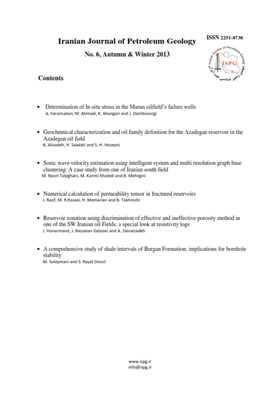Sonic wave velocity estimation using intelligent system and multi resolution graph base clustering: A case study from one of Iranian south field
Subject Areas :
Abstract :
Compressional and shear velocity are two fundamental parameters, which have many applications in petrophysical, geophysical, and geomechanical operations. These two parameters can be obtained using Dipole Sonic Imaging tool (DSI), but unfortunately this tool is run just in few wells of a field. Therefore it is important to predict compressional and shear velocity indirectly from the other conventional well logs that have good correlation with these parameters in wells without these logs. Classical methods to predict the mentioned parameters are utilizing correlations and regression analysis. However, the best tool is intelligent systems including Artificial Neural Network, Fuzzy Logic, Adaptive Neuro Fuzzy Inference System, and Multi resolution graph base clustering for performing such tasks. In this paper 1321 data points from Kangan and Dalan formations which have compressional and shear velocity are used. These data are divided into two groups: 995 and 326 data points were used for construction of intelligent systems and model testing, respectively. The results showed that despite differences in concept, all of the intelligent techniques were successful for estimation of compressional and shear velocities. The Multi resolution graph base clustering. The method had the best performance among the others due to precise clustering the data points. Using this method, the compressional and shear velocity were correlated with correlation factor of 0.9505 and 0.9407, respectively. The developed model does not incorporate depth or lithological data as a part of the inputs to the network. This means that utilized methodology is applicable to any field

